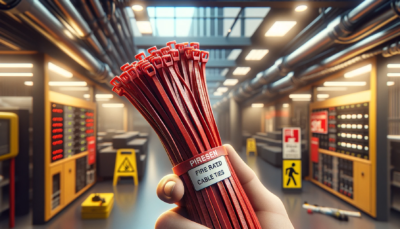When it comes to securing cables in high-temperature environments, using the right materials is crucial for ensuring reliability and safety. Heat resistant cable tie material plays a key role in withstanding elevated temperatures without compromising performance. In this comprehensive guide, we'll delve into what heat resistant cable tie material is, how it works, and why it's essential for various applications.
Understanding Heat Resistant Cable Tie Material
Heat resistant cable tie material refers to polymers or compounds specifically designed to withstand elevated temperatures without melting, deforming, or losing their integrity. These materials are engineered to maintain their strength and durability even in extreme heat conditions, making them ideal for use in industries such as automotive, aerospace, electronics, and manufacturing. Common heat resistant materials used in cable ties include polyamide (nylon), polypropylene, and specialty thermoplastics.
In addition to their ability to withstand high temperatures, heat resistant cable tie materials offer excellent resistance to chemicals, UV radiation, and environmental factors, further enhancing their suitability for demanding applications. By understanding the properties and capabilities of heat resistant cable tie materials, users can make informed decisions when selecting ties for their projects and ensure reliable performance in challenging environments.
Choosing the Right Heat Resistant Cable Tie Material
When choosing heat resistant cable tie material, several factors should be considered to ensure compatibility with the application requirements. These factors include the maximum operating temperature, exposure to chemicals or solvents, mechanical stress, and environmental conditions. Selecting the appropriate material based on these factors is essential for maximizing the longevity and effectiveness of cable tie installations.
Polyamide (nylon) cable ties are a popular choice for general-purpose applications requiring heat resistance up to approximately 185°F (85°C). For higher temperature requirements, specialty thermoplastics such as polyphenylene sulfide (PPS) or polyetheretherketone (PEEK) offer superior heat resistance and mechanical properties. Polypropylene cable ties are also suitable for moderate temperature applications and provide excellent chemical resistance.
When in doubt, consult with cable tie manufacturers or industry experts to determine the most suitable material for your specific application needs. By choosing the right heat resistant cable tie material, users can ensure reliable and durable fastening solutions in even the most challenging environments.
Best Practices for Using Heat Resistant Cable Ties

1. Understand Application Requirements
Before selecting heat resistant cable ties, assess the specific requirements of your application. Consider factors such as temperature range, exposure to chemicals or solvents, mechanical stress, and environmental conditions. Understanding these requirements will help you choose the most suitable cable ties for your needs.
2. Choose the Right Material
Select heat resistant cable tie material based on the operating temperature and environmental conditions of your application. Nylon, polypropylene, and specialty thermoplastics like polyphenylene sulfide (PPS) or polyetheretherketone (PEEK) offer varying degrees of heat resistance and mechanical properties. Choose a material that can withstand the temperatures and conditions present in your environment.
3. Ensure Proper Installation
Proper installation is crucial for the effectiveness and reliability of heat resistant cable ties. Ensure that the tie is securely fastened around the cables or components without over-tightening, which could cause damage or deformation. Use appropriate tensioning tools and follow manufacturer recommendations for installation.
4. Regularly Inspect for Wear and Damage
Regularly inspect heat resistant cable ties for signs of wear, damage, or deterioration. Check for any cracks, fraying, or brittleness that may indicate the need for replacement. Promptly replace worn or damaged ties to maintain the integrity of the fastening system and prevent potential failures or accidents.
5. Consider Reusability
Opt for reusable heat resistant cable ties for applications where adjustments or repositioning may be necessary. Reusable ties feature a release mechanism that allows them to be easily undone and reused multiple times, reducing waste and saving time and resources.
6. Store Properly
Store heat resistant cable ties in a cool, dry place away from direct sunlight and extreme temperatures. Exposure to heat, humidity, or UV radiation can degrade the material and weaken the ties over time. Proper storage helps preserve the integrity and performance of the ties until they are ready to be used.
7. Dispose Responsibly
Dispose of used heat resistant cable ties responsibly to minimize environmental impact. Consider recycling options for nylon ties where available, or choose biodegradable alternatives for eco-friendly disposal. Avoid littering or leaving discarded ties in the environment, as they can pose hazards to wildlife and ecosystems.
Wrapping Up
In conclusion, heat resistant cable tie material plays a critical role in ensuring durability and performance in high-temperature environments. By understanding the properties and capabilities of different materials such as nylon, polypropylene, and specialty thermoplastics, users can select the most suitable material for their specific application requirements.
Whether it's automotive, aerospace, electronics, or manufacturing, choosing the right heat resistant cable tie material is essential for maintaining reliability and safety in cable management. Explore our latest blog posts for more insights and tips on cable ties and related products.

